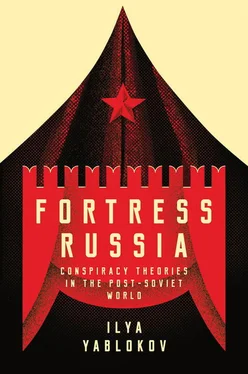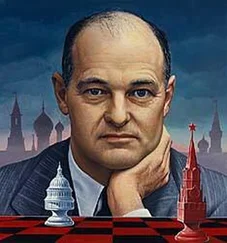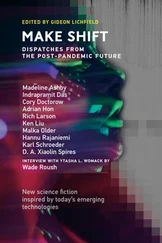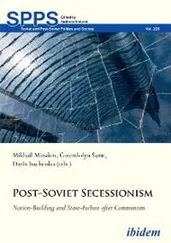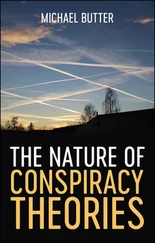The main thing is that we are together. We are a multi-ethnic, but single and powerful nation. I want to tell you that we do not reject anyone, do not attach labels ( shel’muem ) or push anyone away. On the contrary, we urge everyone to unite for our country, certainly all those who consider our Russia their own country, who are ready to take care of it, value it, and believe in it. And we ask everyone not to look out at the distant horizon (ne zagliadyvat’ za bugor)… [not to] go abroad and not to cheat at the expense of our Motherland, but to be together with us, work for it and its people and love the way we love it – with all our heart. (Sholomon84, 2012)
In this crucial remark, Putin reiterated some of the key points of the speech he had delivered in November 2007 at the high point of the parliamentary campaign, when he introduced the notorious idea of ‘jackals who beg for scraps at foreign embassies’. The use of similar notions in 2012 demonstrated Putin’s consistent use of anti-Western conspiracy theories in electoral strategies that sought to mobilize Russian society by dividing it into ‘the people’ and the subversive pro-Western minority.
Yet there were differences between the campaigns in 2007 and 2012. In 2007, anti-Western conspiracy theories were part of an elaborate and well-prepared campaign which delegitimized specific organizations and parties to ensure the smooth transfer of power from Putin to his chosen successor. The situation in 2012 was different. The campaign centred on Putin’s return; this was the overarching narrative of Kremlin propaganda. At the same time, the protest movement, which erupted in December 2011, significantly radicalized the campaign, turning it into a crusade against the vague and undifferentiated ‘orange threat’ of the opposition ‘from Bolotnaia’. This was heavily based on anti-Western conspiratorial rhetoric.
A corpus of anti-Western conspiratorial perceptions, which became the intellectual base of the 2012 campaign, was developed by public intellectuals in the 2000s. They depicted Russia as a besieged country perceived by the West as a mere repository of natural resources. At the same time, Putin’s rhetoric combined conspiratorial allegations, which were based on the discourse produced by his ‘support group’, and appeals for national unity. The conspiratorial aspect of this rhetoric was mainly focused on the supposed threat represented by treacherous opposition politicians and irresponsible intellectuals (Malinova, 2012, p. 83). Every conspiratorial allegation used by Putin was aimed at delegitimizing the arguments of his political opponents and was disseminated by means of newspaper articles, blog posts and documentaries shown on state-aligned television channels. The campaign vividly juxtaposed the images of ‘the real people’ and the ‘Other’ by organizing an ‘Anti-Orange’ rally that mirrored the street activities of the opposition, as well as marches in support of Putin, both of which were widely covered in the media.
In autumn 2014, amid the Ukraine crisis, Viacheslav Volodin, Surkov’s successor as first deputy of the Presidential administration, stated: ‘If there’s Putin, there’s Russia; if there were no Putin, there would be no Russia’ (Sivkova, 2014). Thus, the Kremlin’s new ideologist revealed the extent to which the cult of Putin is pivotal for post-Soviet nation-building. The propaganda campaign that pervaded Russian society in 2014 helped create the illusion of an encircled nation that was led and protected solely by Putin. As this chapter has demonstrated, the first steps leading to this situation were taken back in the 2000s to secure the transfer of the presidency to Medvedev. Both electoral campaigns ,in 2007–8 and 2011–12, were tests to see if the regime was able to preserve its leadership and patronal networks and prepared a set of ideas and policies to sustain the Kremlin’s grip on power.
Constructed by spin doctors and intellectuals in Luzhniki and on Poklonnaia Hill, ‘Putin’s majority’ of 2012 in fact consisted of diverse social groups that could not be convincingly brought together under a single descriptive term, nor even considered to exist in real life. Through biased television programming and sociological polls (Morar’, 2007) produced by Kremlin-funded polling agencies, the architects of electoral campaigns created the image of an overwhelming majority of ‘the people’ who supported Putin’s candidacy.
The image of Putin which appeared in the Kremlin-controlled media during the electoral campaigns consistently made him out to be a genuine ‘people’s politician’. His public appearances and the staged support from ordinary working people combined to establish his connection with ‘real Russia’ and sustain his leadership position. The campaign thus followed well-established populist tactics. Panizza describes the populist leader thus: (2005, p. 21): ‘a political figure who seeks to be at the same time one of the people and their leader, the populist leader appears as an ordinary person with extraordinary attributes’. Attempts on the part of intellectuals loyal to the Kremlin to create an image of Putin which stressed his global importance, and to create a public cult around him, emphasized this ‘extraordinary aspect’ of a populist leader (Sedakov, Vernidub and Guseva, 2007). Moreover, Putin was presented as the embodiment of ‘the people’, who were expected to unite over the populist demands for sovereignty and independence from the West. This Manichean division of the population into in-groups and out-groups is another marker of the populist approach taken by Putin’s team, an approach which was also practised by other populists across Europe (Mudde, 2007).
Research suggests (Colton and Hale, 2014) that the public response to this division has been fairly positive. Despite the drop in the country’s economic performance and hence in personal incomes after 2008, many Russians continued to support Putin. This populist division of society, which was used once again during the presidential campaign of 2012 to ensure Putin’s victory in what was a critical period for the regime, seems to have proved an efficient means of mobilizing citizens in support of Putin.
The 2007 parliamentary elections were grounded in Putin’s personal popularity. The uncertainty of his political future after 2008 created the opportunity for alarmist appeals to protect the country from a ‘plunder’ which would be as catastrophic as the dramatic changes of the 1990s which, as we have discussed, were alleged to be connected to a ‘Western conspiracy’. Seeing the 2007–8 electoral period as a crucial event in the fate of the regime, the ruling political elites prepared the necessary ideological background to justify Putin’s continuation in power. Anti-Western conspiracy theories, which had been actively developed by Kremlin-aligned intellectuals with the aim of delegitimizing potential opposition, were an integral part of this project.
In contrast, the application of anti-Western conspiracy theories during the 2012 presidential campaign was an attempt to deal with the decrease in public support for Putin and his regime. The authorities had failed to note important shifts in society, and had to face the consequences of this failure when the protest demonstrations began after the 2011 parliamentary elections. Because it was so vague and fragmented, the idea of the ‘Putin majority’ had to be actively promoted again, and this was accomplished by means of an aggressive media campaign which took place in January–March 2012 and which demonized political opponents and civil activists. In short, anti-Western conspiratorial mythmaking became an essential part of electoral practices. It was used to provide a simple explanation of current events, shift responsibility for social and economic problems onto other social actors, and delegitimize political opponents. Numerous spin doctors and public intellectuals contributed to the anti-Western agenda. In charge of think tanks and publishing houses, they were able to initiate media campaigns and create conspiratorial schemes with the aim of helping the Kremlin achieve its political goals and, above all, securing Putin’s victory in the presidential elections. Their power to divide the country will become even more obvious during the conflict in eastern Ukraine.
Читать дальше
Конец ознакомительного отрывка
Купить книгу
